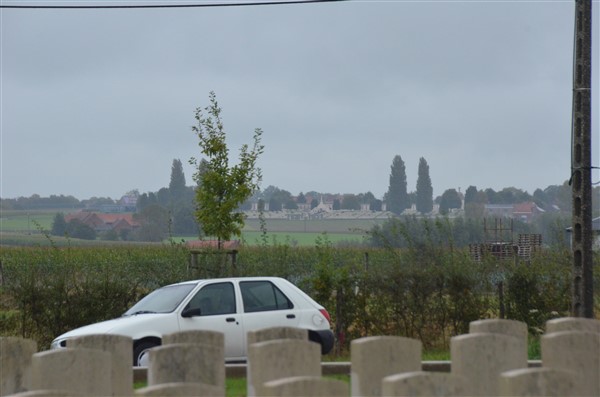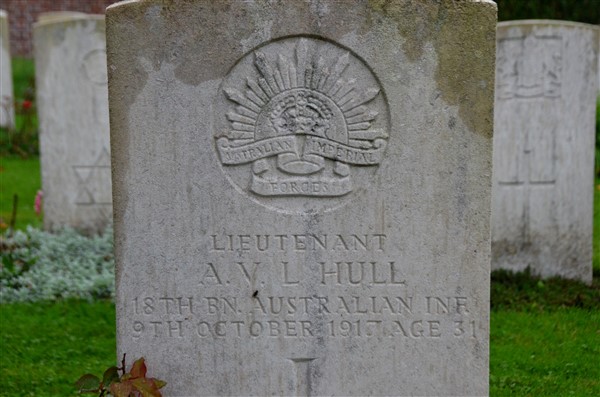Please find below some pictures of the remembrance organized by the Friends of the In Flanders Fields Museum at the British military cemetery
Dochy Farm New British Cemetery at Sint-Juliaan on Wednesday 9 October 2024. The remembrance was held for Arthur Vincent Leopold Hull who died on 09/10/1917 and who is buried on this cemetery.
.jpg)
Patrick Rapoye, volunteer at the In Flanders Fields Museum in Ieper, did the research on this soldier (see below).
.jpg)
View on Tyne Cot Cemetery at Passendale.

.jpg)
The New Zealand commemorative column at 's Graventafel, Passendale.
.jpg)
The Last Post
.jpg)
.jpg)
Followed by the Exhortation and one minute silence.
.jpg)
A family member of Arthur Hull laid a wreath.
.jpg)
.jpg)
The Reveille
.jpg)
Thanking the organizers on behalf of the family.
.jpg)
.jpg)

The Remembrance for Lieutenant Arthur Vincent Leopold Hull at the Dochy Farm New British Cemetery at Langemark Langemark-Poelkapelle was organised on the occasion of a visit by relatives from Australia to Flanders Fields and their wish to also visit the place where Arthur Vincent Leopold Hull, found his final resting place. Family had already visited in previous years, including in 2022 Arthur Hull's niece Victoria Harrington, daughter of his sister Daisy, to whom he sent his last postcard from Poperinge on 26 September 1917 before being killed at the Battle of Poelkapelle on 9 October 1917. Victoria Harrington meticulously transcribed Arthur Hull's letters and postcards, which were then digitized by her daughter Melinda and made available on the following website:
https://stidhull.com.
.jpg)
Arthur Vincent Leopold Hull was born on 29 July 1886 in Moama, New South Wales (NSW), Australia, the son of Walter John and Rose Hull. The Hull family would eventually number nine children, with Arthur as the eldest son. Within the family, Arthur was known as Stid’. Apparently, as a child he had a game with horses to which he always gave the command steady, steady’, which was understood as stiddy, stiddy’. Hence the name Stid’. Arthur Vincent Leopold Hull attended Echuca Grammar School and then became a farmer farmer ’) in his native region. Moama and Echuca are about 225 km from Melbourne.
On 5 February 1915, Arthur Hull enlisted in the Australian Imperial Force (A.I.F.) and, as a private', was assigned the position of signaller’, a task he would continue to perform in various places and capacities until his death. According to his Attestations Papers’, when he entered service, Arthur Hull was 169 cm tall and weighed 61 kg. He had blue eyes, black hair, was unmarried and declared to belong to the Church of England as a religion. Arthur Hull, like his father and other family members, was a member of a Masonic lodge.
Arthur Vincent Leopold Hull left Sydney on 25 June 1915 with the 18th Battalion, 5th Brigade, 2nd Division, A.I.F., for Egypt and then in early August 1915 for the front on the Gallipoli peninsula, where his battalion was part of the Mediterranean Expeditionary Force (M.E.F.). After evacuating from Gallipoli, Arthur Hull arrived via the Greek island of Lemnos, back at Alexandria on 9 January 1916. This was followed by further training in Egypt. On 18 March 1916, Hull left Alexandria and arrived at Marseille a week later. In France, the 18th Battalion, A.I.F., was deployed to the Somme near Pozières, among other places, in July 1916.
Hull was made corporal on 19 November 1916 and sergeant on 23 January 1917. Because of his dedication and achievements, especially as a signalman, his commanding officer sent him to the Officers Cadet Battalion in Oxford on 2 February 1917 to train as an officer. During this training, he stayed at the New College in Oxford. On 31 May 1917, he was commissioned 2nd lieutenant. On 10 August 1917, he left Southhampton bound for Le Havre in France. He rejoined the 18th Battalion on 11 September 1917, which was then at Steenvoorde, just across the Belgian border. Shortly afterwards, the 18th Battalion entered Belgium, where the Third Battle of Ypres, or the Battle of Passchendaele ’, was in full swing.
The Third Battle of Ypres went through several phases. According to official historiography, it started on 31 July 1917 with preparatory attacks and artillery bombardments by the French and British armies. The second phase began on 20 September 1917 with the Battle of the Menin Road, followed by the Battle of Polygon Wood, the Battle of Broodseinde, the Battle of Poelkapelle and the first Battle of Passchendaele (12 October 1917). The third phase ran from 26 October to 10 November 1917, during which Passchendaele was eventually taken but no further progress could be made.
The 18th Battalion, A.I.F. and Arthur Vincent Leopold Hull took an active part in the battle of the Menin Road (20 to 25 September 1917) and the battle of Poelkapelle (9 October 1917). Arthur Hull's involvement in these battles has been described in many publications. This is partly because Arthur Vincent Leopold Hull was mentioned twice, albeit in footnotes, in the official Australian war history of World War I, compiled by C.E.W. Bean in 1938: The Official History of Australia in the War of 1914 1914-1918, Volume IV, The A.I.F. in France: 1917’. Regarding the death of Arthur Hull, the following was stated by C.E.W. Bean: "(9 October 1917) Accordingly [orders issued], at 9.15 the 18th and part of the 19th Battalions were sent forward. The 18th had moved up to the old front line, and in accordance with orders, established a new headquarters on Broodseinde Ridge. The pillbox chosen, the only one large enough, lay in view of the Germans and was also in their new barrage line. At this place Lieutenant A. V. L. Hull, signalling officer, while sending a message by Lucas lamp, was sniped through the neck. He was pulled into a shell shell-hole and his wound was dressed. Later, an incendiary shell ignited the camouflage of brushwood and the timber of the dugout. Lieut. A. W. Irvine pulled Lieut. A. T. Doig out of the fire but Lieut. A.V.L. Hull, Sergeant R. G. Fountain and 10 others were killed. killed.” The place of death of Arthur Hull, is marked on the British Trench Maps as Marne ’ and is close to where Tyne Cot Cemetery is now located.
9 October 1917, the day Arthur Vincent Leopold Hull fell, was one of the bloodiest days during the Third Battle of Ypres. According to the List of Names of the In Flanders Fields Museum, there were 4989 casualties on this day, of which 387 in the A.I.F, 3080 in the British Army (B.E.F.) and 1328 in the German Army (D.K.H.). Another event involving Arthur Hull, described by C.E.W. Bean, concerned an attack on 20 September 1917 during the Battle of Menin Road and not during the Battle of Polygon Wood as is sometimes claimed. The first part of this 1938 description corresponded to the Report on Operations 19/22nd Sept 1917’, as recorded in the War Diary of the 18th Battalion and dated 22 September 1917.
The relevant paragraphs on Anzac House in this report read as follows: ‘[20 September1917] At ANZAC fifteen men [Germans], two guns and a Telefunken set were taken. Here a dog carrying a message was captured and message sent to Brigade. A number of maps etc. were also sent back. Another dog was shot near the HANEBEKE. HANEBEKE.” … ANZAC was found to contain two rooms about 14 feet by 12 feet and an observation tower ( about 6 feet square) on top. A small Australian flag was placed on ANZAC and remained there until the house was heavily bombarded next day. day.” … On the afternoon of the 21st. the enemy opened up a methodical bombardment of ANZAC, CARTER POINT and various concrete pill boxes ” in the area. ANZAC came in for a particularly rough treatment, the enemy evidently attempting to knock out the O.P. [Observation Point] there. Five other ranks and a dog were killed here by one shell and a number wounded. Portions of a Telefunken set were destroyed and a number of stores damaged. The battalion was relieved during the night.
However, C.E.W. Bean added: The name Anzac ” caused this blockhouse to be of especial interest to the Australians, and a miniature Australian flag, obtained from the Comforts Fund, was placed on it by Lieutenant A. V. L. Hull (Lockhart, NSW) of the 18th Battalion, and flew there until the heavy shelling next day. day.” The misunderstanding that it would have been an Australian national flag and not a little red flag of the Australian Comforts Fund may have arisen because this event was creatively ’ copied by Alfred Pearse, a British official war painter. Postcards depicting this painting were also made and sold to benefit the activities of the Australian Comforts Fund. This organization, run mainly by women, provided Australian troops with free comforts ’ such as tobacco, chocolate, newspapers, pastries and knitted items.
Postcard with print of Alfred Pearse's painting The Battle of Polygon Wood ’, as published on 14 August 1918 in the Daily Advertiser newspaper (Wagga Wagga, NSW, Australia)
.jpg)
On 9 October 1917, at the battle of Poelkapelle, Arthur Vincent Leopold Hull was killed, having received news less than a week before, that he was being promoted to lieutenant. Arthur Vincent Leopold Hull was first buried where he had been killed. In November 1919, he was reburied in Dochy Farm New British Cemetery (VIII.D.19). The epitaph, recited by mother Rose Hull, reads as follows: Sleep, For Your Sleep Has Been Nobly Won ’. Arthur Vincent Leopold Hull is also commemorated on panel 85 of the Australian War Memorial and on the William Thompson Masonic Schools First World War Memorial at Baulkham, Australia.
Page made by WO1.be / Greatwar.be.